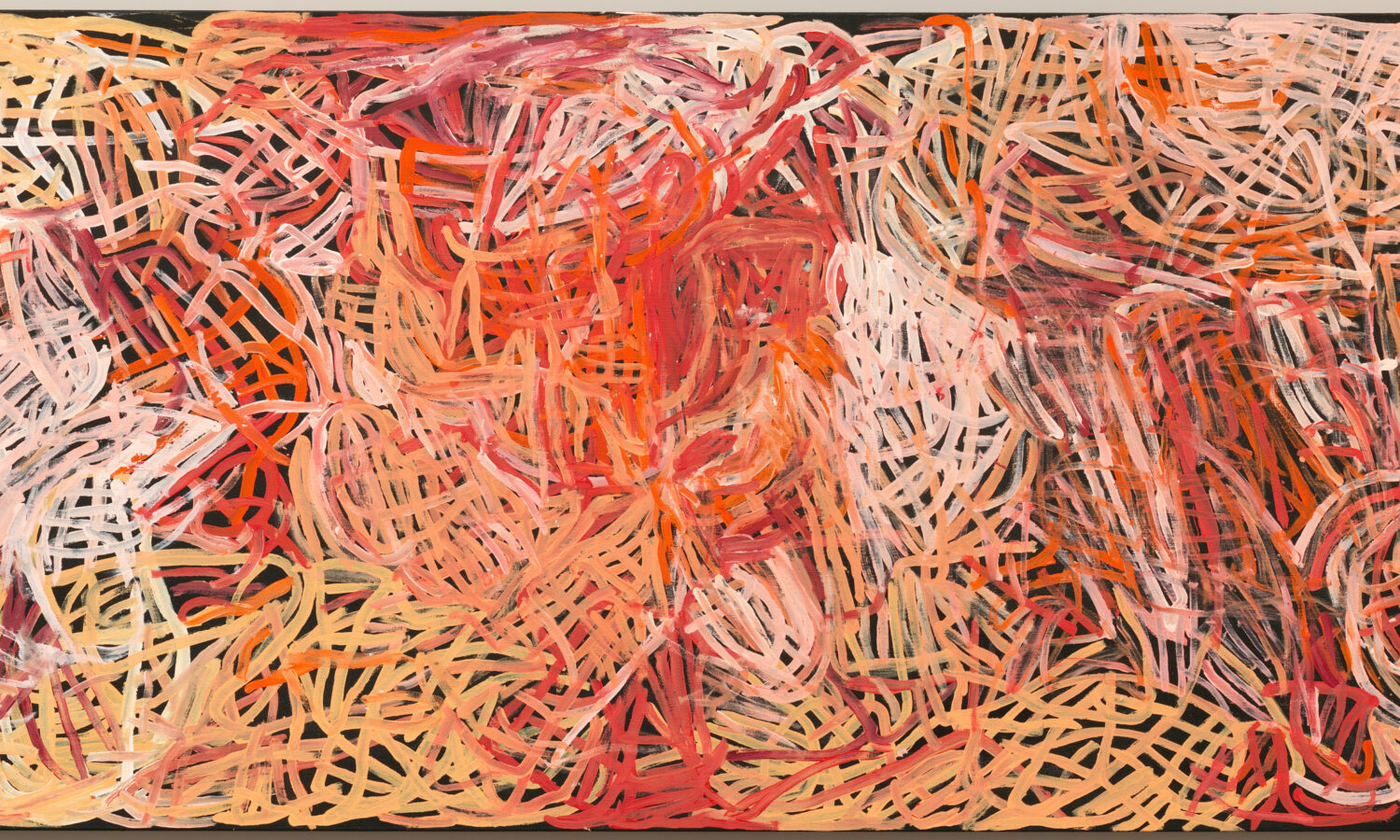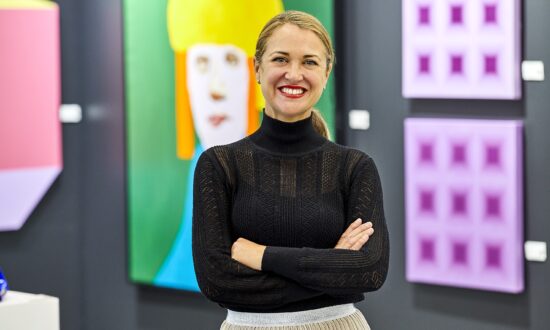This summer the National Gallery of Australia is surveying the significant career of the artist, Emily Kam Kngwarray.
Emily to most people.
She is one of only a few Australian women artists known by one name. The exhibition Emily Kam Kngwarray is the first act, as it will be followed by a Tamarind Tree Pictures documentary. The third act will be at London’s Tate Modern in June 2025.
Emily Kam Kngwarray’s life story is full of intriguing contrasts. Born about 1914 on her Alhalker Country, she was part of the first contact (with white people) generation, yet the batik and paintings she made in the last 19 years of her life shifted understandings of what Aboriginal art was and could be.
Soon after her death in 1996 her work was shown at the 1997 Venice Biennale as Fluent (with Judy Watson, Waanyi and Yvonne Koolmatrie, Ngarrindjeri). This recognition placed her at the pinnacle of international contemporary art.
Yet the meaning and cultural power of her art, for Kngwarray and her family, remains at odds with its understanding and reception in the marketplace and in the context of art and its histories.
Kngwarray spent her life in the Sandover region of the central desert, north of Alice Springs (Mparntwe). She began making batik in 1977 but during the following decade switched to canvas. This was a less onerous medium and also placed her work firmly within the fine art market.
Many audiences will read her work in the context of abstraction and modernism, yet for Kngwarray and her family these are cultural portraits of Country.
In the book accompanying the exhibition, Stephen Gilchrist writes: “Kngwarray’s paintings of place are better understood as threshold objects that create openings onto Anmatyerr lands, life ways, life cycles and life forces … Her wish to paint her Country in all its contours was a devotional exercise that energised the places she was connected to and would ultimately return to.”
She was prolific, producing about 3000 canvases during her painting years. She was also the first of a generation of Aboriginal women who began making art late in their lives. Those following, with short and brilliant careers, include Mirdidingkingathi Juwarnda Sally Gabori (1924-2015) and Mavis Ngallametta (1944-2019).
The thirst for their work is related to their status as the first and the last. The last of a first-contact generation who were among the first to convey their understanding of country and culture visually in aesthetically pleasing, culturally significant and historically important ways.
An “Emily” is both powerful within her own Alhakerre context, and a trophy (visible in the loans to the exhibition, which includes works from national, international and private collections, notably Perth-based Janet Holmes a Court; and Steve Martin and Anne Stringfield, in New York).
So, what does the new NGA show tell us about Emily that we didn’t know from two previous institutional surveys – one at the Queensland Art Gallery in 1998, another at the National Museum of Australia in 2008?
While it explores Emily’s development, contextualised with the paintings on batik that began her creative career, the involvement of family in the exhibition also shares what we may not have previously understood about her legacy.
In a short film, women’s “paint up” (awely) is explored, making sense of Kngwarray’s stylistic shift to thickly painted stripes and expressing the power of this ceremony. It offers insights into what her descendants see so powerfully in her work.
Jedda Kngwarray Purvis and Josie Petyarr Kngwarray suggest: “If you close your eyes and imagine the paintings in your mind’s eye, you will see them transform. They are real — what Kngwarray painted is alive and true. The paintings are dynamic and keep on changing, and you can see how realistic they are … The Country transforms itself, and those paintings do as well. That’s why the old woman is famous.”
Batik works float, moving gently in the air in the first three rooms, a presence and context. In these depths of patterning and layers her country, the emu (ankerr) markings, pencil yam (anwerlarr) and fan flower (intekw) are detailed with a view from above and within that is a hallmark of desert painting. You can spend a long time looking into these works, which take you somewhere else altogether.
Kngwarray’s work had marked shifts in subject and expression, with the detailed layers of the first room segueing to painted stripes (awely) and larger dots. The final three rooms see her motifs simplify, brushstrokes grow thicker and larger, stripes and dots adding variety to the lacey marks from before.
And their momentum builds, in both scale and motif. The monumental Yam awely, 1995, builds with line, colour and layers in a mesmerising manner, her sense of spatial composition instinctive and unerring.
There is much to celebrate here, the expansive canvases, the colourful and masterful evocation of country and the presence and acknowledgement, at the highest and international level, of her talent and its contradictions.
The exhibition’s London season was announced by Tate Britain’s director Maria Balshaw during the Betty Churcher Memorial lecture in Canberra recently when she explained that it would be displayed in the famous Turbine Hall of Tate Modern.
The attraction to European audiences is likely to build on intense interest in Australia’s First Nations peoples and their art, and fits within the context of Balshaw’s ambitions for the Tate’s many galleries and programs.

Get InReview in your inbox – free each Saturday. Local arts and culture – covered.
Thanks for signing up to the InReview newsletter.
As the NGA’s summer exhibition, the show encourages a 2023 trend (seen in QAGOMA’s showcase of exhibitions by Michael Zavros and eX De Medici) that suggests artists from Australia are worthy of blockbuster status and an admission price.
Emily Kam Kngwarray also sits within the NGA’s Gender Equity Action Plan (addressing the imbalance in both collections and exhibitions) and its ongoing Know My Name program.
Emily’s ability to reinvent Aboriginal painting has transcended time, space and culture. Curators Hetti Perkins and Kelli Cole suggest that Kngwarray’s descendants have the final word on her legacy. “They simply describe her art as arraty ilem — telling the truth.”
No matter on what level we understand them, these paintings have power. After this exhibition and its three acts, even more people will know her name.
Emily Kam Kngwarray, National Gallery of Australia, Canberra, until April 28, 2024; nga.gov.au
Louise Martin-Chew travelled to Canberra courtesy of The National Gallery of Australia
Support local arts journalism
Your support will help us continue the important work of InReview in publishing free professional journalism that celebrates, interrogates and amplifies arts and culture in South Australia.
Donate Here




